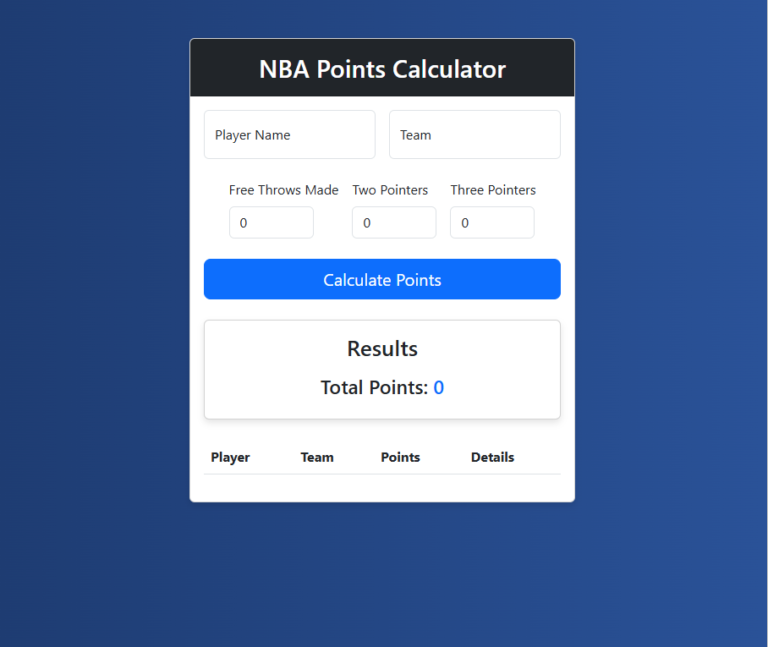Passing Rating Calculator: Maximize Your Quarterback Stats
A Passing Rating Calculator determines a quarterback’s efficiency based on completions, yards, touchdowns, and interceptions. It provides a numerical value to gauge performance.
Quarterback performance is crucial in football, and the Passing Rating Calculator helps evaluate it. This tool uses specific metrics like completions, passing yards, touchdowns, and interceptions to calculate a quarterback’s rating. Coaches, analysts, and fans use these ratings to compare quarterbacks and assess their effectiveness.
By inputting game statistics, you can quickly determine a quarterback’s proficiency. This rating system is integral in making informed decisions about player performance and potential. Overall, it simplifies complex data into an understandable format, aiding both casual viewers and football professionals.
Introduction To Passing Rating
The passing rating is a key statistic in football. It helps evaluate the performance of quarterbacks. Coaches and analysts use this metric to assess passing efficiency. Understanding passing rating can enhance your appreciation of the game.
Importance In Football
The passing rating is crucial in football. It measures a quarterback’s success in passing. A high rating often means a player is doing well. Teams rely on this rating to make strategic decisions. Fans also use it to compare players.
Historical Context
In the past, football lacked a standard metric for passers. The passing rating system was introduced to fill this gap. It was created in the 1970s. This system provided a consistent way to measure quarterback performance. Since then, it has become a staple in football analysis.
Key Metrics In Passing Rating
The passing rating is an essential measure of a quarterback’s performance. It uses several key metrics to provide an accurate picture. Understanding these metrics can help you gauge a quarterback’s effectiveness.
Completion Percentage
Completion percentage is a crucial metric in passing rating. It shows the number of successful passes compared to attempts. A higher completion percentage indicates greater accuracy.
Here’s a simple formula to calculate it:
Completion Percentage = (Completions / Attempts) 100
For example, if a quarterback completes 25 out of 30 attempts, the completion percentage is:
(25 / 30) 100 = 83.33%
Yards Per Attempt
Yards per attempt is another vital metric. It measures the average yardage gained per passing attempt. This shows the quarterback’s ability to make significant plays.
Here’s how you calculate it:
Yards Per Attempt = Total Passing Yards / Attempts
For instance, if a quarterback throws for 300 yards on 40 attempts, the yards per attempt is:
300 / 40 = 7.5
Touchdowns
Touchdowns are key in evaluating a quarterback’s scoring ability. More touchdowns generally mean a more effective quarterback. Touchdowns can significantly boost the passing rating.
- Touchdowns show scoring efficiency.
- They reflect the quarterback’s skill in the red zone.
Interceptions
Interceptions can negatively affect a quarterback’s rating. They represent mistakes and missed opportunities. Fewer interceptions indicate better decision-making.
Here’s a simple table to show the impact of interceptions:
| Number of Interceptions | Impact on Rating |
|---|---|
| 0 | Positive |
| 1-2 | Neutral |
| 3+ | Negative |
Managing interceptions is crucial for maintaining a high passing rating.
Calculating The Passing Rating
Understanding how to calculate the passing rating in sports is crucial. It helps evaluate player performance accurately. This section will explain the formula and steps involved.
Formula Breakdown
The passing rating formula is straightforward but involves multiple components. Here’s a simple breakdown:
- Completion Rate: Measures successful passes.
- Yards Per Attempt: Average yards gained per attempt.
- Touchdowns: Number of touchdown passes.
- Interceptions: Number of interceptions thrown.
Each component is calculated and then combined to get the final rating.
Step-by-step Guide
- Calculate Completion Rate:
- Formula:
(Completions / Attempts) 100 - Example:
(25 / 30) 100 = 83.33
- Formula:
- Calculate Yards Per Attempt:
- Formula:
Yards / Attempts - Example:
250 / 30 = 8.33
- Formula:
- Calculate Touchdown Rate:
- Formula:
(Touchdowns / Attempts) 100 - Example:
(3 / 30) 100 = 10
- Formula:
- Calculate Interception Rate:
- Formula:
(Interceptions / Attempts) 100 - Example:
(1 / 30) 100 = 3.33
- Formula:
- Combine All Rates:
- Sum up all the calculated rates.
- Example:
83.33 + 8.33 + 10 - 3.33 = 98.33
The final value is the passing rating. This number helps to judge the player’s performance in a game.
Common Mistakes
Using a Passing Rating Calculator can be tricky. People often make errors. These mistakes can lead to incorrect results. Let’s look at some common mistakes people make.
Overlooking Key Metrics
Ignoring important metrics is a big mistake. Metrics like completion percentage, yards per attempt, and touchdown-to-interception ratio are crucial. Leaving out any of these can skew results.
Here is a simple table to show the key metrics:
| Metric | Importance |
|---|---|
| Completion Percentage | High |
| Yards per Attempt | Medium |
| Touchdown-to-Interception Ratio | High |
Misinterpreting Data
Misunderstanding the data can lead to wrong conclusions. Ensure you understand what each metric means. For example:
- Completion Percentage: The ratio of completed passes to attempted passes.
- Yards per Attempt: Average yards gained per passing attempt.
- Touchdown-to-Interception Ratio: Number of touchdowns divided by interceptions.
These definitions help avoid misinterpretation.
Here is a sample code snippet to calculate the passing rating:
function calculatePassingRating(completions, attempts, yards, touchdowns, interceptions) {
let a = ((completions / attempts) - 0.3) 5;
let b = ((yards / attempts) - 3) 0.25;
let c = (touchdowns / attempts) 20;
let d = 2.375 - ((interceptions / attempts) 25);
return ((a + b + c + d) / 6) 100;
}
Use this function to avoid manual errors.
Advanced Metrics For Quarterbacks
In the world of football, quarterback performance is key. Traditional stats like passing yards and touchdowns provide some insights. But advanced metrics offer a deeper understanding. They reveal a quarterback’s true efficiency and effectiveness. Let’s explore two crucial advanced metrics for quarterbacks.
Adjusted Net Yards
Adjusted Net Yards (ANY) is an essential metric. It considers passing yards, touchdowns, and interceptions. It also includes sacks, providing a fuller picture of performance. Here’s the formula for ANY:
ANY = (Passing Yards + (20 Passing Touchdowns) - (45 Interceptions) - Sack Yards) / Pass Attempts
This formula helps evaluate a quarterback’s efficiency. Higher numbers indicate better performance. It’s a vital tool for comparing quarterbacks.
Total Quarterback Rating
Total Quarterback Rating (QBR) is another critical metric. It measures a quarterback’s overall impact on the game. QBR considers various factors, including:
- Passing plays
- Rushing plays
- Game context
- Opponent strength
QBR is scaled from 0 to 100. A higher score means better performance. It’s a comprehensive metric that captures a quarterback’s true value.
Here’s how QBR breaks down:
| QBR Range | Performance Level |
|---|---|
| 75-100 | Elite |
| 50-74 | Above Average |
| 25-49 | Average |
| 0-24 | Below Average |
These metrics, ANY and QBR, provide valuable insights. They help teams assess quarterback performance more accurately. Fans and analysts can also use these metrics for better evaluations.
Improving Quarterback Stats
Boosting a quarterback’s stats is crucial for team success. A better passing rating can make the difference in tight games. There are several ways to achieve this. Here, we focus on training regimens and game strategies.
Training Regimens
Effective training can elevate a quarterback’s performance. It starts with a well-structured regimen.
- Daily Drills: Practice throwing accuracy with short and long passes.
- Strength Training: Build core muscles to enhance throwing power.
- Footwork: Improve agility for better movement in the pocket.
- Film Study: Analyze game footage to understand mistakes.
- Recovery: Proper rest and nutrition for muscle recovery.
Let’s look at some basic drills:
| Drill | Purpose |
|---|---|
| Target Practice | Improve throwing accuracy |
| Scramble Drills | Enhance mobility and decision-making |
| Arm Strength Drills | Increase throw distance |
Game Strategies
Strategic play can greatly impact a quarterback’s stats. Knowing the right strategies is key.
- Play Action: Fake handoffs to confuse the defense.
- Quick Passes: Use short passes to avoid sacks.
- Read Defense: Recognize defensive setups for better pass choices.
- Two-Minute Drill: Practice fast-paced plays for critical moments.
- Red Zone Efficiency: Focus on scoring when close to the end zone.
Here are some specific strategies:
- Screen Pass: Use screen passes to counter aggressive defenses.
- Audibles: Change plays at the line of scrimmage based on defense.
- Spread Formation: Use multiple receivers to spread the defense.
Combining these training regimens and game strategies can significantly improve a quarterback’s stats. This leads to a higher passing rating and more wins for the team.
Tools And Resources
Understanding a player’s passing rating is essential for evaluating performance. Utilizing the right tools and resources can simplify this process. Below, we explore various tools to help you calculate passing ratings efficiently.
Online Calculators
Online calculators are user-friendly and accessible from any device. They require minimal input and quickly provide results.
- Easy to Use: Enter basic stats to get the passing rating.
- Free Access: Many online calculators are free to use.
- Instant Results: Get immediate feedback on player performance.
These calculators often include helpful guides and explanations. This ensures you understand the results and how they are calculated.
Analytical Software
Analytical software offers more advanced features for in-depth analysis. Ideal for coaches and analysts, this software provides detailed insights.
| Feature | Description |
|---|---|
| Advanced Metrics | Analyze a wide range of performance metrics. |
| Custom Reports | Create tailored reports for individual players. |
| Data Visualization | Visualize data with charts and graphs. |
Such software may require a subscription but offers superior analysis capabilities. It is suitable for those needing detailed player performance insights.
Case Studies
Understanding the Passing Rating Calculator involves examining real-world examples. Case studies help us see how this tool works in action. By analyzing specific players, we can better grasp its impact.
Top Nfl Quarterbacks
Let’s look at some of the top NFL quarterbacks. They showcase how the Passing Rating Calculator reflects their performance.
| Quarterback | Passing Yards | Touchdowns | Interceptions | Passer Rating |
|---|---|---|---|---|
| Tom Brady | 4,633 | 40 | 12 | 102.2 |
| Aaron Rodgers | 4,299 | 48 | 5 | 121.5 |
| Patrick Mahomes | 4,740 | 38 | 6 | 108.2 |
These quarterbacks consistently achieve high passer ratings. This highlights their skill and efficiency.
Statistical Outliers
Statistical outliers show unique cases. They help us understand extremes in passer ratings.
- High Ratings: Sometimes, a quarterback scores above 150. This shows exceptional performance.
- Low Ratings: Ratings below 50 can indicate poor games. Such ratings are rare but important to analyze.
Outliers provide valuable insights into different playing conditions. They can show how various factors impact a quarterback’s game.
Frequently Asked Questions
How To Calculate Passing Rating?
Calculate passer rating using: [(Comp/Att – 0. 3) * 5 + (Yards/Att – 3) * 0. 25 + (TDs/Att) * 20 + 2. 375 – (INTs/Att) * 25] / 6.
What Is Considered A Good Passing Rating?
A good passing rating is typically 60% or higher. This can vary based on the specific context or institution.
What Is The Passing Rating Scale?
The passing rating scale typically ranges from 0 to 100. A score of 70 or above is usually considered passing.
How To Get 158.3 Passer Rating?
To get a 158. 3 passer rating, complete 77. 5% of passes, average 12. 5 yards per attempt, throw a touchdown on 11. 875% of attempts, and have no interceptions.
Conclusion
Mastering the passing rating calculator can enhance your understanding of player performance. It provides valuable insights for coaches and fans. By utilizing this tool, you can make informed decisions and appreciate the game’s intricacies. Embrace the passing rating calculator to elevate your football analysis to the next level.


